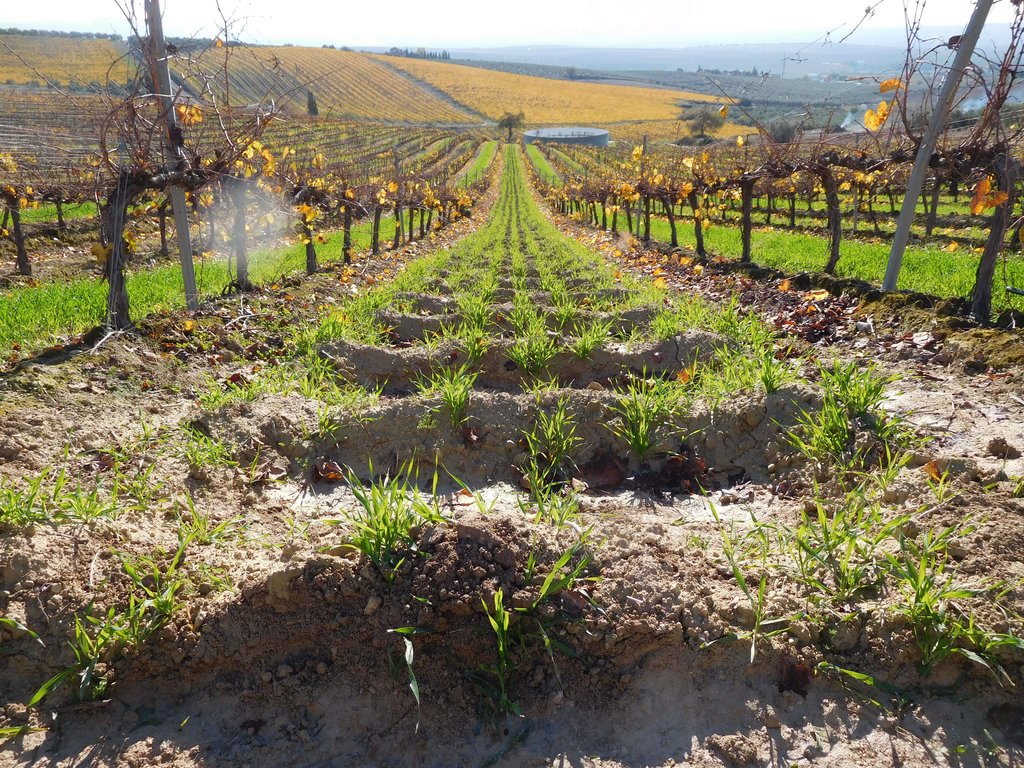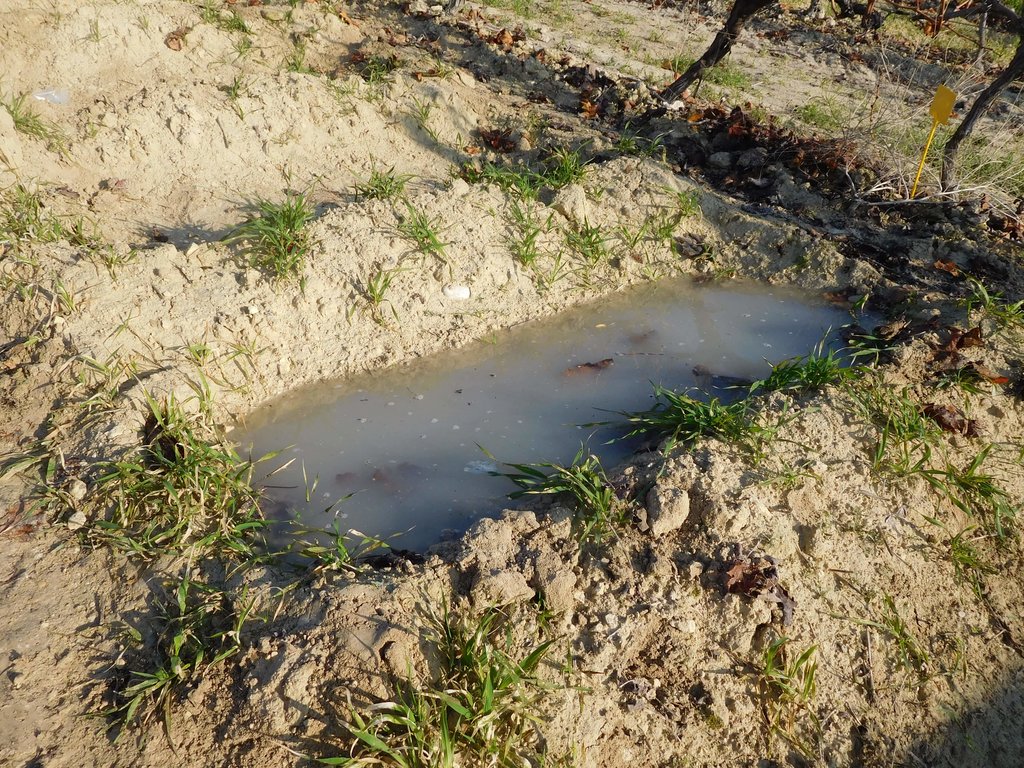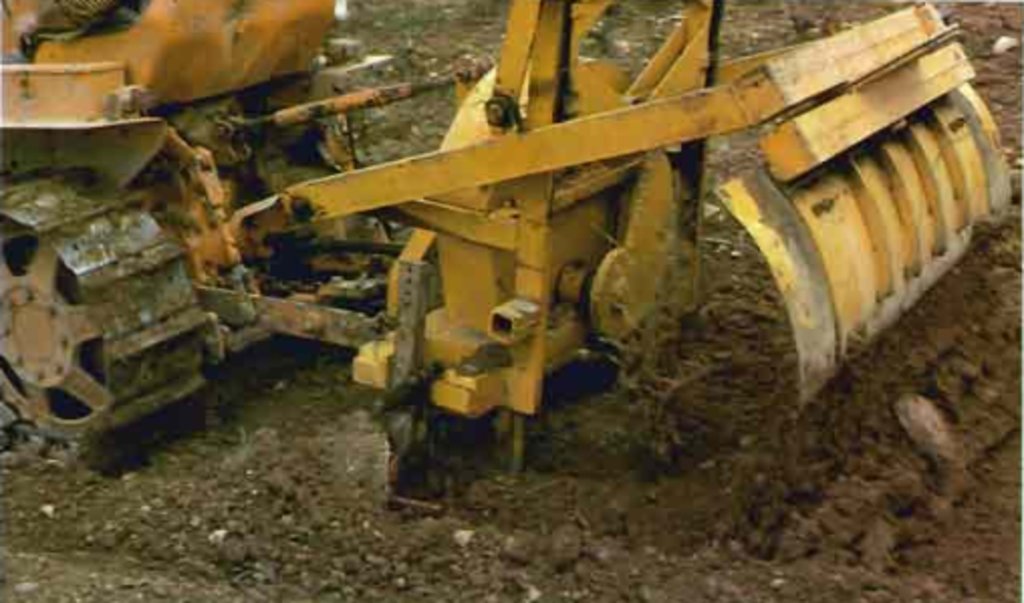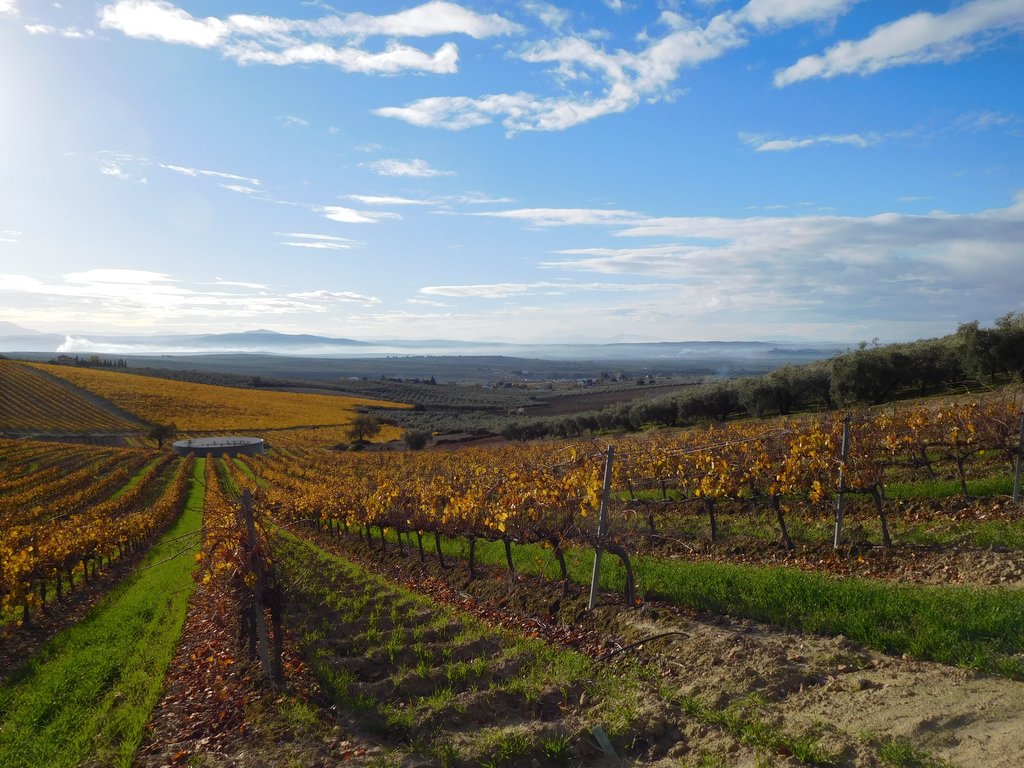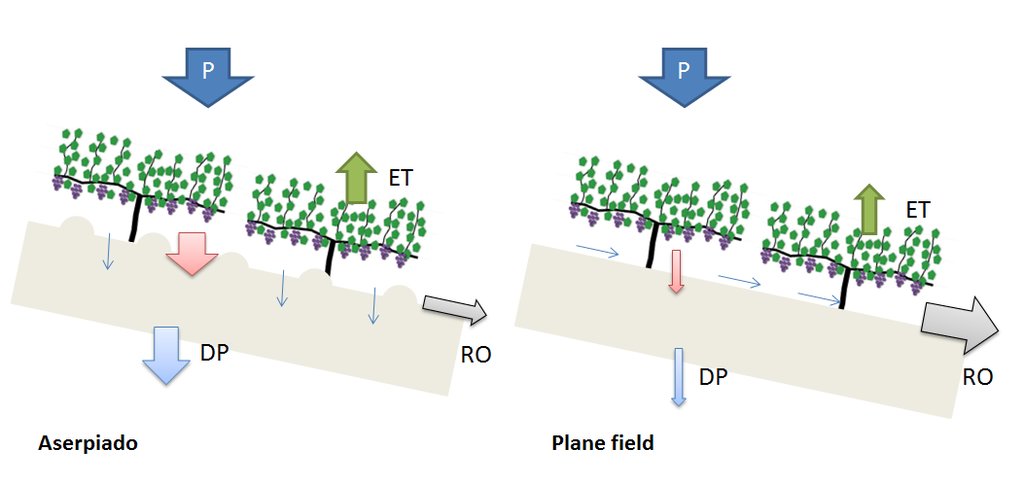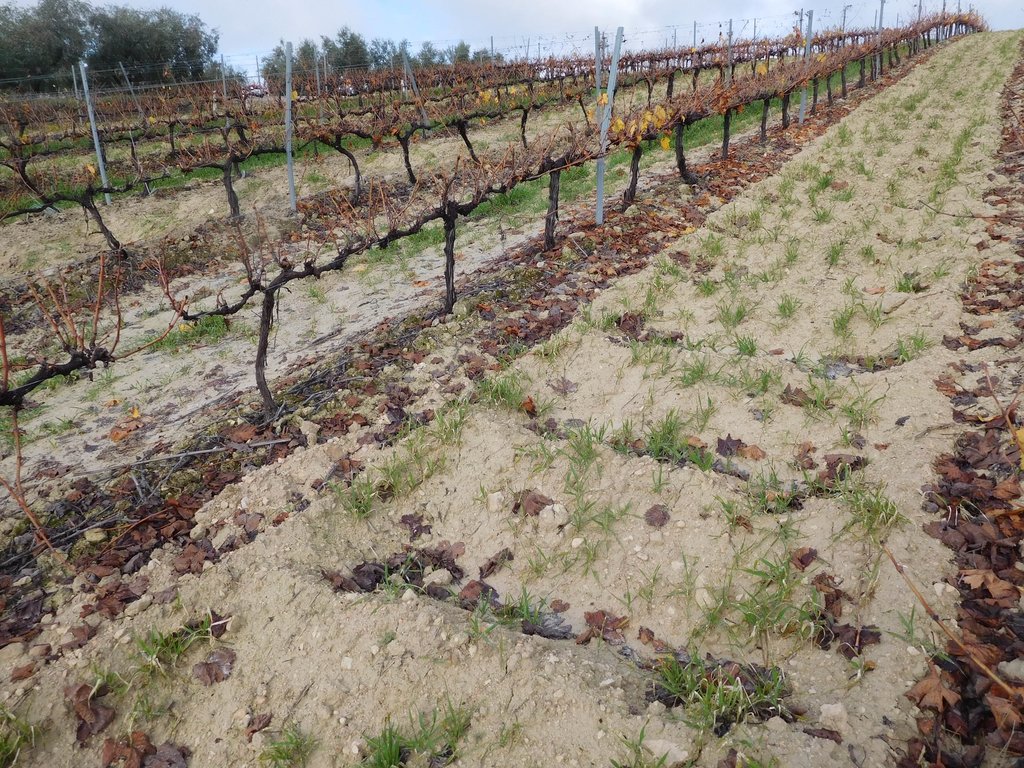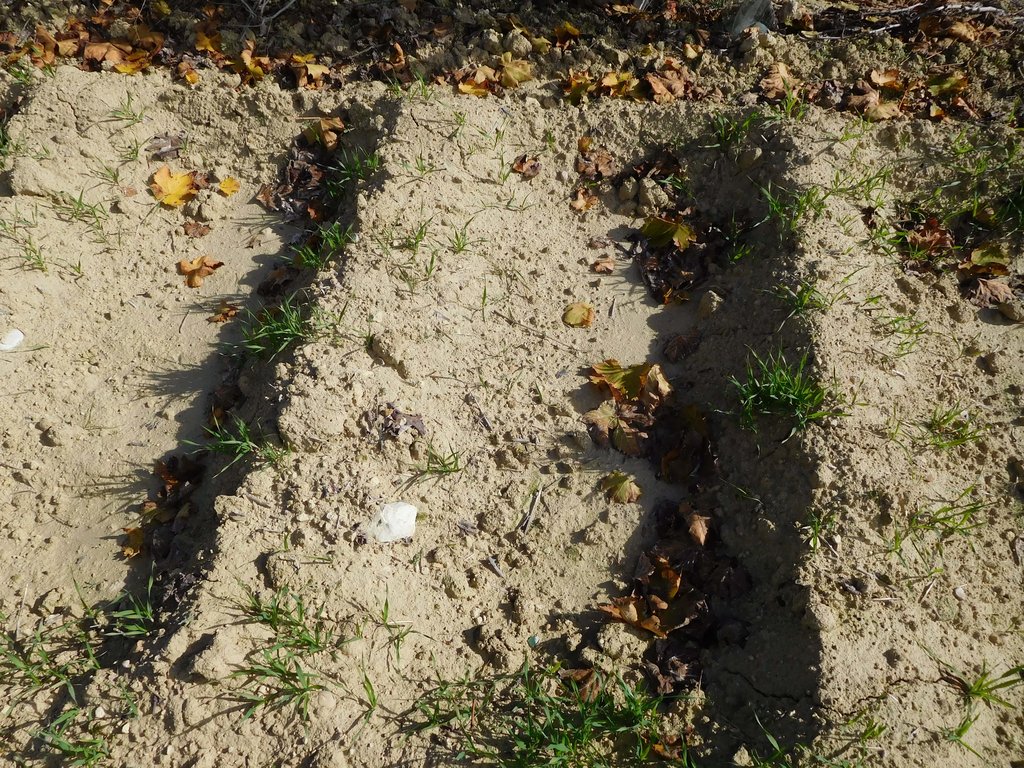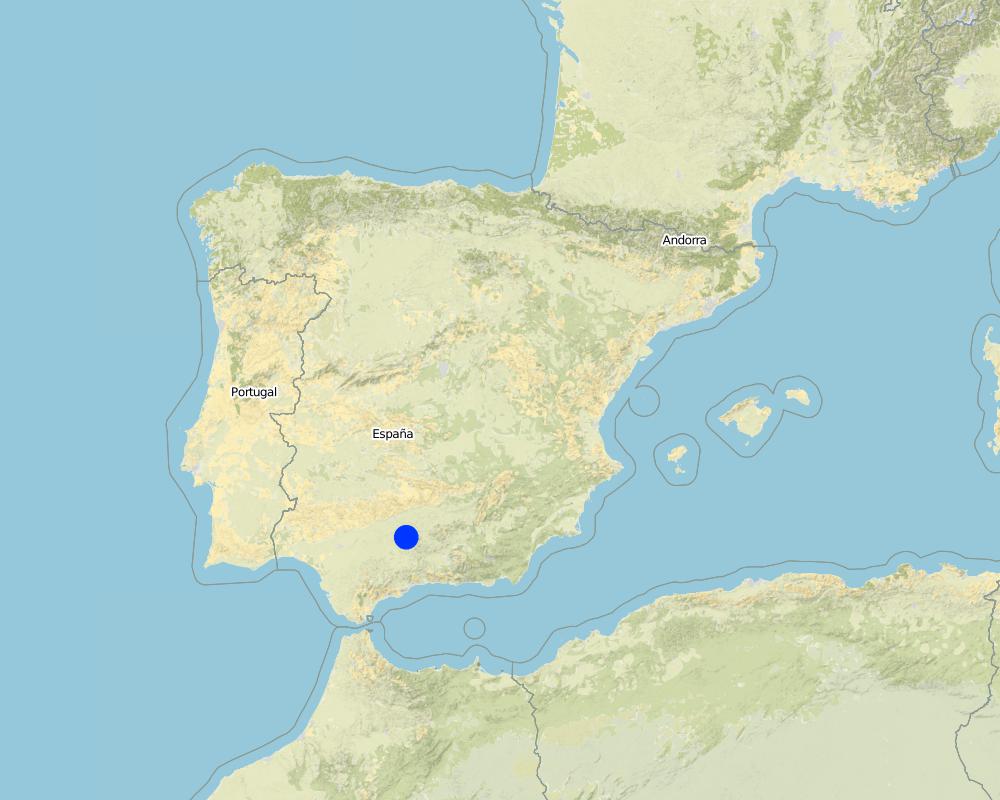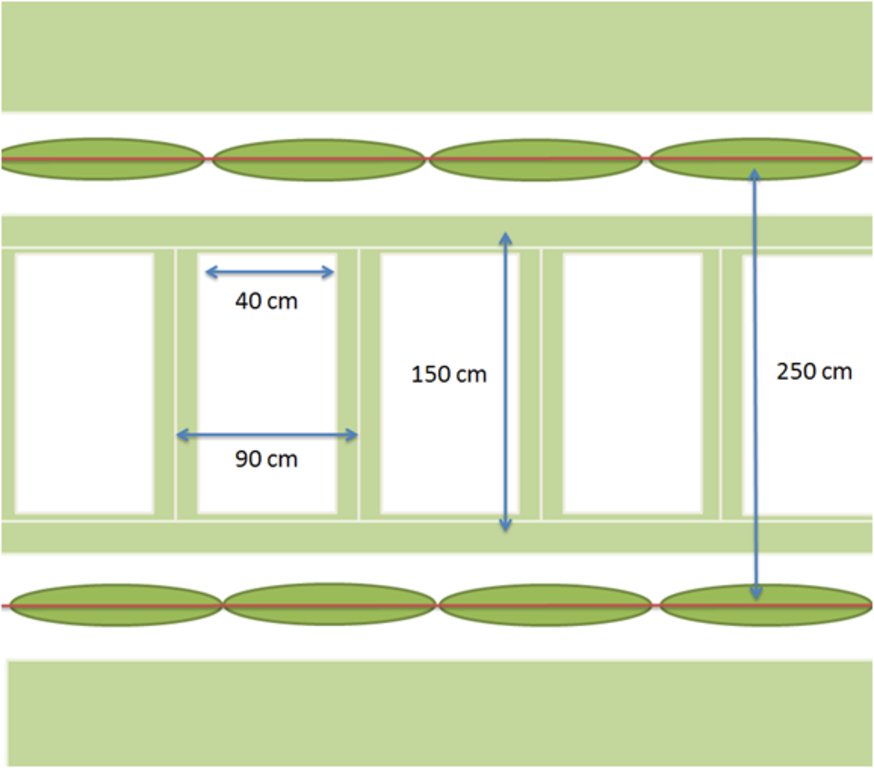Aserpiado [西班牙]
- 创建:
- 更新:
- 编制者: Wolfgang Duifhuizen
- 编辑者: Gema Guzmán
- 审查者: Ursula Gaemperli, Alexandra Gavilano
Aserpiado or Alumbrado
technologies_907 - 西班牙
查看章节
全部展开 全部收起1. 一般信息
1.2 参与该技术评估和文件编制的资源人员和机构的联系方式
土地使用者:
Jiménez Manuel
Finca Cañada Navarro
西班牙
土地使用者:
Jiménez Santiago
Finca Cañada Navarro
西班牙
SLM专业人员:
有助于对技术进行记录/评估的机构名称(如相关)
Wageningen Environmental Research (Alterra) (Wageningen Environmental Research (Alterra)) - 荷兰有助于对技术进行记录/评估的机构名称(如相关)
Consejo Superior de Investigaciones Científicas - Instituto de Agricultura Sostenible (CSIC - IAS) - 西班牙1.3 关于使用通过WOCAT记录的数据的条件
编制者和关键资源人员接受有关使用通过WOCAT记录数据的条件。:
是
1.4 所述技术的可持续性声明
这里所描述的技术在土地退化方面是否存在问题,导致无法被认为是一种可持续的土地管理技术?:
否
2. SLM技术的说明
2.1 技术简介
技术定义:
Aserpias are micro-depressions within a field along all or alternate inter vines rows, made by a tillage tool. The main objective of implementing Aserpiado is to let water infiltrate on-site, thereby increasing soil moisture and plant available water, decreasing runoff and associated losses of soil.
2.2 技术的详细说明
说明:
Aserpiado (also known as Alumbrado) is applied in vineyards in Southern Spain in lower and mid altitudes where the climate is characterized by relative high rainfall during winter, but almost none in summer. This requires adoptions in the water management like irrigation or on-site storage of water.
With the aserpiado technique, seasonal soil bunds are made every autumn in order to limit irrigation requirements and to protect the soil against erosion. These contour bunds in the allies remain in place the entire winter to make best use of precipitation that occurs mostly during this period.
The functioning of Aserpias was analysed in a vineyard within the Appellation of Origin Montilla-Moriles in Córdoba, the only previously existing documentation on this measure comes from vineyards in the Jerez wine region. Farmers use Aserpiado because it is the only way to get enough water without irrigation, as when irrigation is applied it cannot get the protected ‘Jerez-Sherry’ label.
The microbasins are made in the inter-row area by dragging a caterpillar tractor pulled (see picture Aserpiadora) hydraulic beam over the field which lifts leaving a heap of soil behind. The speed and interval of the beam are set in such a way that a bund is made every 1.5 meter. Some users sow barely directly in advance of making the aserpiado which results in a high plant cover of the bunds during winter. The main function of Aserpiado is to catch rainwater which otherwise would be lost runoff. With Aserpiado the runoff is close to zero this means more water should become available for the crops.
The required inputs for creating and maintaining aserpias depends upon whether the bunds are permanent or seasonal. If permanent the ridges should be checked regulary and maintained by hand. When the aserpiado is only present during the winter season regular tillage in summer is necessary to keep the soil workable so the 'aserpiadora' (specialized tillage tool) can create the aserpias in autumn which are removed in spring to ease field traffic. With a modern-day Aserpiadora a farmer can create 3 to 5 ha of aserpias a day (Narvaez, 1980). The impacts of establishing aserpias are less soil erosion, less runoff and more water storage in the soil. Land users like Aserpiado as it is a very effective way to increase soil moisture and reduce soil erosion, when used in combination with cover crops the soil quality also improves over time.
2.3 技术照片
关于照片的一般说明:
url source of Aserpiadora picture: http://www.mapama.gob.es/ministerio/pags/biblioteca/hojas/hd_1980_19.pdf
2.5 已应用该技术的、本评估所涵盖的国家/地区/地点
国家:
西班牙
区域/州/省:
Andalucia, Cordoba Province
有关地点的进一步说明:
Finca Cañada Navarro, Montilla
具体说明该技术的分布:
- 适用于特定场所/集中在较小区域
注释:
The only previously existing documentation on Aserpias features vineyards of D.O. Jerez, but is also used elsewhere like in the D.O. of Montilla-Moriles data was compiled. Popularity of this measure is unknown as very little documentation exists.
Map
×2.6 实施日期
如果不知道确切的年份,请说明大概的日期:
- 不到10年前(最近)
2.7 技术介绍
详细说明该技术是如何引入的:
- 通过土地使用者的创新
- 作为传统系统的一部分(> 50 年)
注释(项目类型等):
Written texts exist of Aserpias being used in vineyards near Jerez de la Frontera in the 1860's which were made either by hand with a hoe or with a mule dragging a beam (Gonzalez Moreno, 2011). It is not an easily found in the Montilla-Moriles region; it is mainly developed in the Appellation of Origin of Jerez. However, the combination of Aserpiado and cover crops is the result of the innovation of some farmers who have been implementing it since 2011.
Aserpias have been used since the XIX century mainly in the Jerez being a common practice not only in vineyards but also in olive orchards, especially in steep slopes farms. No data found about the actual extension of this practice. The combined used with cover crops is fundamentally implemented by this farmer who started doing this practice in 120 ha.
3. SLM技术的分类
3.1 该技术的主要目的
- 改良生产
- 减少、预防、恢复土地退化
- 结合其他技术保护流域/下游区域
- 适应气候变化/极端天气及其影响
- 创造有益的经济影响
3.2 应用该技术的当前土地利用类型

农田
- 一年一作
- 多年一作(非木材)
- 乔木与灌木的种植
年作 - 具体指明作物:
- 谷类 - 大麦
乔木和灌木种植 - 指定作物:
- 葡萄
每年的生长季节数:
- 1
注释:
Aserpias are only used if vine rows are perpendicular to slope. Documentation exists also of Aserpias being used in olive orchards (Narvaez, 1980).
Biodiversity was not analyzed.
3.4 供水
该技术所应用土地的供水:
- 雨养
注释:
Measure is applied to decrease necessity of supplemental irrigation.
3.5 该技术所属的SLM组
- 改良的地面/植被覆盖
- 集水
- 灌溉管理(包括供水、排水)
3.6 包含该技术的可持续土地管理措施

农艺措施
- A1:植被和土壤覆盖层
- A3:土壤表面处理

植物措施
- V2:草和多年生草本植物
注释:
Cover crops are not used in all sites with Aserpiado
3.7 该技术强调的主要土地退化类型

土壤水蚀
- Wt:表土流失/地表侵蚀
- Wg:冲沟侵蚀/沟蚀
注释:
Local circumstances and agricultural practices make agricultural soils very prone to water erosion.
3.8 防止、减少或恢复土地退化
具体数量名该技术与土地退化有关的目标:
- 防止土地退化
- 减少土地退化
注释:
The main goal is to increase water availability, but also decreases soil losses in inter-row areas.
4. 技术规范、实施活动、投入和成本
4.1 该技术的技术图纸
技术规范(与技术图纸相关):
The bunds stretch over most of the inter-row alley, but in order not to expose superficial roots the bunds are 1.5 m wide so at each side there is about half a meter distance from the stems. Often the bunds are covered with barley and pruning residues. The bunds itself are 15 to 20 cm high and usually spaced 90 cm apart leaving 40 cm space at the base. At Cañada Navarro the Aserpia-bunds and sides are covered with barley as a cover crop during winter, in other sites where Aserpiado is applied the bunds remain bare.
作者:
Wolfgang Duifhuizen
日期:
23/01/2017
4.2 有关投入和成本计算的一般信息
具体说明成本和投入是如何计算的:
- 每个技术区域
注明尺寸和面积单位:
22 hectares
其它/国家货币(具体说明):
Euros
如相关,注明美元与当地货币的汇率(例如1美元=79.9巴西雷亚尔):1美元=:
0.94
4.5 维护/经常性活动
| 活动 | 时间/频率 | |
|---|---|---|
| 1. | Tillage with cultivator (15-20 cm deep) | After harvest crop |
| 2. | Sowing barley in allies | Autumn |
| 3. | Making aserpias in every other alley | Soon after sowing barley |
| 4. | Killing cover crop | Early in march |
| 5. | Tillage with cultivator (removing aserpias) | After killing the cover crop |
4.6 维护/经常性活动所需要的费用和投入(每年)
| 对投入进行具体说明 | 单位 | 数量 | 单位成本 | 每项投入的总成本 | 土地使用者承担的成本% | |
|---|---|---|---|---|---|---|
| 劳动力 | Tractor driver | h/ha | 5.5 | 40.0 | 220.0 | 96.0 |
| 设备 | Scarifier | h/ha | 1.5 | 40.0 | 60.0 | 100.0 |
| 设备 | Seeder | h/ha | 2.25 | 40.0 | 90.0 | 100.0 |
| 设备 | Aserpiadora | h/ha | 1.5 | 40.0 | 60.0 | 100.0 |
| 设备 | Cultivator | h/ha | 1.5 | 40.0 | 60.0 | 100.0 |
| 植物材料 | Barley seed | kg/ha | 80.0 | 0.2 | 16.0 | |
| 肥料和杀菌剂 | Herbicide** | l/ha | 3.0 | 6.67 | 20.01 | |
| 技术维护所需总成本 | 526.01 | |||||
| 技术维护总成本,美元 | 559.59 | |||||
注释:
*herbicide is not used when mechanical control is applied
4.7 影响成本的最重要因素
描述影响成本的最决定性因素:
The cost of Aserpiado and sown tasks compared to conventional farming.
5. 自然和人文环境
5.1 气候
年降雨量
- < 250毫米
- 251-500毫米
- 501-750毫米
- 751-1,000毫米
- 1,001-1,500毫米
- 1,501-2,000毫米
- 2,001-3,000毫米
- 3,001-4,000毫米
- > 4,000毫米
指定年平均降雨量(若已知),单位为mm:
600.00
有关降雨的规范/注释:
High annual variability and erratic rainfall patterns, historical precipitation records show an annual variation between 300 and 1200 mm.
注明所考虑的参考气象站名称:
Santaella IFAPA station
农业气候带
- 半干旱
The Montilla region characterized by hot and dry summers, chilly winters and very few days of rainfall.
5.2 地形
平均坡度:
- 水平(0-2%)
- 缓降(3-5%)
- 平缓(6-10%)
- 滚坡(11-15%)
- 崎岖(16-30%)
- 陡峭(31-60%)
- 非常陡峭(>60%)
地形:
- 高原/平原
- 山脊
- 山坡
- 山地斜坡
- 麓坡
- 谷底
垂直分布带:
- 0-100 m a.s.l.
- 101-500 m a.s.l.
- 501-1,000 m a.s.l.
- 1,001-1,500 m a.s.l.
- 1,501-2,000 m a.s.l.
- 2,001-2,500 m a.s.l.
- 2,501-3,000 m a.s.l.
- 3,001-4,000 m a.s.l.
- > 4,000 m a.s.l.
说明该技术是否专门应用于:
- 不相关
5.3 土壤
平均土层深度:
- 非常浅(0-20厘米)
- 浅(21-50厘米)
- 中等深度(51-80厘米)
- 深(81-120厘米)
- 非常深(> 120厘米)
土壤质地(表土):
- 中粒(壤土、粉土)
土壤质地(地表以下> 20厘米):
- 中粒(壤土、粉土)
表土有机质:
- 中(1-3%)
如有可能,附上完整的土壤描述或具体说明可用的信息,例如土壤类型、土壤酸碱度、阳离子交换能力、氮、盐度等。:
Most soils in the region are Cambisols by FAO classification with quite homogeneous well-drained soil consisting mostly of silty clay loam which has a good water holding capacity.
5.4 水资源可用性和质量
地下水位表:
5-50米
地表水的可用性:
中等
水的盐度有问题吗?:
否
该区域正在发生洪水吗?:
否
5.5 生物多样性
物种多样性:
- 中等
栖息地多样性:
- 中等
关于生物多样性的注释和进一步规范:
Biodiversity was not analyzed
5.6 应用该技术的土地使用者的特征
定栖或游牧:
- 定栖的
生产系统的市场定位:
- 商业/市场
相对财富水平:
- 平均水平
个人或集体:
- 个人/家庭
- 合作社
机械化水平:
- 机械化/电动
5.7 应用该技术的土地使用者使用的平均土地面积
- < 0.5 公顷
- 0.5-1 公顷
- 1-2 公顷
- 2-5公顷
- 5-15公顷
- 15-50公顷
- 50-100公顷
- 100-500公顷
- 500-1,000公顷
- 1,000-10,000公顷
- > 10,000公顷
这被认为是小规模、中规模还是大规模的(参照当地实际情况)?:
- 大规模的
5.8 土地所有权、土地使用权和水使用权
土地所有权:
- 公司
- 个人,有命名
土地使用权:
- 个人
5.9 进入服务和基础设施的通道
健康:
- 贫瘠
- 适度的
- 好
教育:
- 贫瘠
- 适度的
- 好
技术援助:
- 贫瘠
- 适度的
- 好
就业(例如非农):
- 贫瘠
- 适度的
- 好
市场:
- 贫瘠
- 适度的
- 好
能源:
- 贫瘠
- 适度的
- 好
道路和交通:
- 贫瘠
- 适度的
- 好
饮用水和卫生设施:
- 贫瘠
- 适度的
- 好
金融服务:
- 贫瘠
- 适度的
- 好
6. 影响和结论性说明
6.1 该技术的现场影响
社会经济效应
水资源可用性和质量
灌溉用水需求
生态影响
水循环/径流
水的回收/收集
地表径流
地下水位/含水层
注释/具体说明:
Water balance modelling on aserpiado fields indicate a high percolation rate
土壤
土壤水分
土壤流失
6.4 成本效益分析
技术收益与技术建立成本相比如何(从土地使用者的角度看)?
短期回报:
非常积极
长期回报:
非常积极
技术收益与技术维护成本/经常性成本相比如何(从土地使用者的角度看)?
短期回报:
中性/平衡
长期回报:
中性/平衡
6.5 技术采用
- 单例/实验
如若可行,进行量化(住户数量和/或覆盖面积):
120 ha (in Montilla-Moriles region)
在所有采用这项技术的人当中,有多少人是自发的,即未获得任何物质奖励/付款?:
- 91-100%
6.6 适应
最近是否对该技术进行了修改以适应不断变化的条件?:
否
6.7 该技术的优点/长处/机会
| 土地使用者眼中的长处/优势/机会 |
|---|
|
1. Storage of water from winter rainfalls. 2. Control of soil erosion. 3. Benefits associated to the cover crops. |
| 编制者或其他关键资源人员认为的长处/优势/机会 |
|---|
|
Control of erosion Increasing infiltration |
6.8 技术的弱点/缺点/风险及其克服方法
| 土地使用者认为的弱点/缺点/风险 | 如何克服它们? |
|---|---|
| No significant disadvantages or higher cost have been noticed compared to a cover crop farm. |
| 编制者或其他关键资源人员认为的弱点/缺点/风险 | 如何克服它们? |
|---|---|
| If the aserpiado fails, concentration of runoff in rills will easily occur. | To make aserpiado large enough to not be overtopped by regular rainstorms, also bunds need to be checked for stability. |
7. 参考和链接
7.1 信息的方法/来源
- 实地考察、实地调查
- 与土地使用者的访谈
Interview with Manuel Jiménez and Santiago Jiménez; agricultural engineers/ vinegrowers working for the Lagar Cañada Navarro wine farm.
- 根据报告和其他现有文档进行编译
(现场)数据是什么时候汇编的?:
01/12/2016
7.3 链接到网络上的相关信息
标题/说明:
El Alumbrado para acumalacion del agua en cultivos leñosos de secano, Revilla Narvaez (in Spanish)
URL:
http://www.mapama.gob.es/ministerio/pags/biblioteca/hojas/hd_1980_19.pdf
标题/说明:
APROVECHAMIENTO DE LAS LLUVIAS EN VIÑEDOS SITUADOS EN LADERAS Y PENDIENTES MEDIANTE “ASERPIADO”, José Mª González Moreno, 2011
标题/说明:
Los viticultores del Marco de Jerez apuestan por la Producción Integrada
URL:
http://www.mapama.gob.es/ministerio/pags/biblioteca/revistas/pdf_vrural/Vrural_1999_87_54_55.pdf
链接和模块
全部展开 全部收起链接
无链接
模块
无模块




